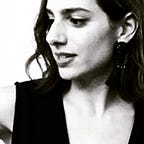This Artist Explores the Terrors of Sleep Paralysis Through Surreal Photography
Nicolas Bruno makes images as haunting as his mysterious condition.
For the majority of his life, photographer Nicolas Bruno has suffered from sleep paralysis. Caught between the waking and dreaming worlds, he hallucinates about malignant entities closing in on him, all-the-while helplessly bound by full-body immobility. Sleep-deprived and petrified, Bruno turned to art to explore his condition.
Sleep paralysis is a mysterious disorder that occurs in approximately 8% of the population. It’s believed to be the result of a signal malfunction in the brain, which, through a natural process called “atonia,” relaxes the muscles during sleep to protect the body from self-inflicted injury. Sleep paralysis is the untimely occurrence of atonia in the liminal state between falling asleep and awakening, fastening the “victim” between the dreaming and conscious worlds.
“I have experienced bone-chilling hallucinations and extreme terror during [my] dreams: faceless silhouetted figures, embraces from shadow-like hands, warping of reality around me — all while being completely paralyzed in the midst of being awake and sleeping,” Nicolas Bruno tells Culture Trip.
“A typical sleep paralysis experience will begin with a low and resonating humming or static. I will awaken and attempt to move my limbs, and immediately realize that I am immobilized and unable to fight the situation. Any attempts to scream out or fight back worsen the wave of anxiety and fear that piles onto your chest like a pouring bag of concrete. The room begins to pulsate and faceless figures will begin to emerge from the corners of my room… The room will seem to fill up with water as I begin to choke, while my ears [fill] with blown-out static and screaming noises.”
While sleep paralysis may evoke unique hallucinations, sufferers report several commonalities: choking, a colossal weight on the chest, a “soul-sucking” sensation, and the perception that one or more intruders–often women–are attacking them. In many cultures, sleep paralysis is subsequently referred to as “The Old Hag”. Some anthropologists hypothesize that sleep paralysis is the derivative of belief in the supernatural.
Bruno’s sleep paralysis reached an unmanageable state by the age of 15. “It took hold of my life and began destroying my wellbeing. I would not sleep for multiple days at a time, which only intensified the dreams… Enormous bouts of insomnia and horrific dreams pushed me to a dark pit of depression…” Only through his art could Bruno begin to communicate the severity of his suffering.
“My final compositions are created with singular or multiple dream experiences. Multiple dream documentations can be combined to inform the concept and symbolism within the piece. These self-portraits and portraits are carefully paired with props or costumes that I fabricate or find on the side of the road,” Bruno explains. He then photographically reimagines his dreams through what he calls his “invented vocabulary of imagery”.
Like a dream, this “vocabulary of imagery” is heavily symbolic. “I use water to symbolize the aspect of being submerged in the paralysis, while also reflecting on the feelings of drowning and suffocation. The physical feats of staying afloat while being bound or climbing buoyant wooden ladders are comparable to the stresses that I experience within the dream. Ladders depict the transition between the realms of sleeping, while heavy rope and threatening instruments menace the sufferer into remaining within the paralysis experience. The list continues to grow as I create and find visual bonds with certain props that I either make or find,” Bruno says.
A recurring characteristic of Bruno’s work–and a familiar trait of sleep paralysis-induced hallucinations–is facelessness. In several of Bruno’s photographs, threatening subjects are without identity. Yet Bruno also obstructs the identity of the victims. “The faceless figures depict the intruders that make their way into my sleep paralysis episodes. They are often aggressive, violent, yet curious. [But] they are [also] a part of me, invited into my room by my subconscious.”
The discomforting presence of dreamlike figures in the conscious space marked the aesthetic of Surrealism, a fantastical avant-garde art movement that rose to prominence in the 1920s. I pointed out that Bruno’s photography, which is undeniably surreal if not Surrealist, is reminiscent of works by Magritte, who was also known to obscure the identity of his subjects. “I am constantly influenced by artists of the past, particularly 19th-century painters and sculptors that challenged the norms of art, such as Géricault and Goya. Magritte also falls into my earlier inspiration, and I often wonder if he experienced sleep paralysis himself,” Bruno says.
Perhaps it is a fair postulation that sleep paralysis has inspired more artists than Bruno. One of the most famous paintings in art history, Henry Fuseli’s The Nightmare (1781) depicts a sleeping woman with a demon-like creature sitting on her chest, and is believed to be one of the first artistic portrayals of the disorder.
For Bruno, photography is a way of creatively working through his hallucinations; creatures that only he can see, though he is certainly not alone in his experience of the phenomenon. “Finding my voice through the creation of my deeply personal imagery gave me the boost that I needed to persevere and grow as an artist,” Bruno reflects. “Becoming a singular character or multiple figures allows me to physically relive the struggles within the dreams, and allows me to have my hand in each part of the image creation.”
On February 25, Haven Gallery will host a solo exhibition of Bruno’s photography and drawings. Between Realms is the first solo survey of the artist’s work, and will examine the ways in which Bruno explores his condition through art.
Between Realms will run through April 2, 2017 at Haven Gallery, 155 Main Street, Northport, NY, 11768.
Rachel Gould is the U.S. Arts Editor for Culture Trip, where this article originally appeared. To read more of her stories, visit here.
